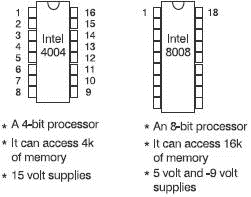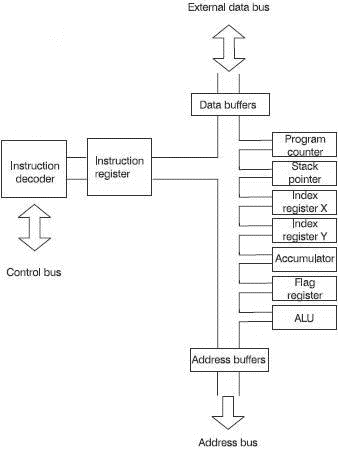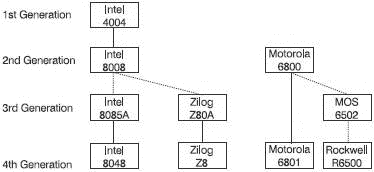Книга: Introduction to Microprocessors and Microcontrollers
Who did what, when
Who did what, when
As we know, our starting point was the Intel 4004 in 1972, very quickly followed by the 8-bit 8008 processor. These are shown in Figure 11.3. Notice that, even within a company, there was no agreement about the operating voltages.

Figure 11.3 The first 4-and 8-bit microprocessors
It also started the trend for numbering, rather than naming, a microprocessor. This made good sense since each basic design generated a series of variations, different speeds, modified instruction sets etc. The numbers can give a clue as to some of the basic characteristics and the hierarchy. Sometimes an X is used to signify a family of devices like the 80X86, so by giving different values to the X, we include the 80286, 80386 etc. The tendency now is to use a name and a number. This was due more to a legal problem owing to the difficulties of ‘owning’ a number. This was highlighted after Intel produced the 80286 followed by the 80386 and 80486, which gave its competitors rather advanced warning of the name of the next one. Intel couldn’t copyright the number 80586 otherwise mathematicians would fear prosecution if any calculation resulted in this number. They tried to call it the P5, claiming world rights over the letter P. Finally they went for ‘Pentium’. Apart from the fun of watching it all going on, the main beneficiaries, as usual, were the corporate lawyers (for whom we all pay, of course).
Intel versus Motorola
In December 1973, Intel introduced the 8080A. This was a very popular processor that had a 16-bit address bus so it can address up to 64 kbytes of memory or, as the adverts said at the time, ‘a MASSIVE 64k of memory’. The power supplies changed again, this time to +5 V, +12 V and –5 V. The number of instructions increased again and the number of pins increased to 40. Internally, there was the normal accumulator and eight general-purpose registers. This, then, became the standard package size for future 8-bit microprocessors as shown in Figure 11.4.

Figure 11.4 A standard size for 8-bit microprocessors
At about the same time, Motorola introduced a rival in the form of the MC6800. Like the Intel 8080A, this one was an 8-bit microprocessor with 16 address pins. At this point, the similarities ended. It was not compatible with the 8080A and so fought toe to toe in the market place, and came second!
The power supplies were simplified, now requiring only a single +5 V supply. A block diagram of the MC6800 is shown in Figure 11.5. We can see that it was unusual in not having any general purpose registers but it did have two accumulators. The approach here was to use an external memory location for the temporary storage of information that all previous microprocessors would have put into an internal register. The remainder of the microprocessor is quite familiar from our look at the Z80 in Chapter 8. The 6800 performed slightly faster than the 8080 on average, but not enough to break the hold of Intel in the marketplace.

Figure 11.5 MC6800 Motorola’s answer to the Intel 8080A
The final 8-bit microprocessors
At this time, Intel was working on the design of a replacement for the 8080A. It was a response to the criticisms of the 8080A: Why does it need three different power supplies when the 6800 only need one? And why only one interrupt pin when the 6800 has two?
At this time some of the engineers that had been working on the 8080A and were developing the replacement called the 8085A decided, or were persuaded, to move to a rival company called Zilog.
Meanwhile, back at Intel, the 8085 was produced. It answered all the gripes about the 8080A and increased the clock speed to 5.5 MHz. Still 8 bits with a 16-bit address bus, it stayed with its eight internal general purpose registers. It followed Motorola’s lead and opted for a single +5 V power supply but to keep its customer base it kept its instruction code compatible with the 8080A.
Back at Zilog, the other group of engineers that was also brought up with the 8080A set to work on the Z80 which was later developed into the Z80180. They combined much that was good about the Intel designs with some good ideas from the MC6800. A single power supply was used and this not only returned to the use of internal general purpose registers but increased their number to 14. The instruction code included all the code from the 8080A but added some new ones to nearly double the total number.
Meanwhile a new player, MOS Technology entered the fray with its own MCS650X family of which the MCS6502 is probably the best known. This flew to fame with the rise of the microcomputer in the 1980s. It was basically an enhancement of the Motorola MC6800 and follows the 8-bit trend of a 16-bit address bus and a single +5 V power supply. Its contribution to progress was the idea of pipelining. Two billion 6502s were sold.
Returning to the plot
The 6502 was said to be ‘accumulator-based’ in that it has no general purpose registers and a single accumulator through which all the incoming and outgoing data is passed but with pipelining and some fast instructions – it was very popular for a few years. In comparing Figure 11.6 with Figure 11.5 we can see the influence of the MC6800. Most of the blocks are the same. The MC6800 had two accumulators and one index register and the MCS6502 has two index registers and one accumulator.

Figure 11.6 MCS6502 – an enhancement of the MC6800
There was little to choose between these microprocessors, as the 6502 had the edge in the microcomputer market while the MC6800 was more popular in the industrial control field.
The one-chip microcomputer
To make a stand alone system, the microprocessor would require some RAM and ROM memory as we saw in Figure 7.6. In many industrial control situations the size of the memory would not need to be very large and it occurred to the designers that all these necessary parts could be built into a single chip. When this occurred the name microprocessor was superseded by the one-chip microcomputer.
Intel produced the 8048. This was not simply an 8085+RAM+ROM, but a new design. It included (yet another) change of instruction code so it was not compatible with either the original 8080A or the 8085A. The on-board memory consisted of 1 kbyte of ROM and 64 bytes of RAM which was quickly doubled to 2 kbytes and 128 bytes on a new version, the 8049. It could also access 4 kbytes of external ROM. A further enhancement was a timer. This can count up or down to provide time delays. Without this, the microprocessor would have to be used for this function which would prevent it from getting on with something more useful.
Zilog, of course, were not far behind. It bought out the Z8. This was similar in concept but slightly upgraded. It had two counter/timers that could be used for counting incoming pulses as well as providing the time delays. It had 2 kbytes of ROM and 128 bytes of RAM that it called general purpose registers. A big improvement was its ability to access 64 kbytes of external ROM and 64 kbytes of external RAM to allow the ‘one-chip’ to become more than one if needed.
Motorola replied with its MC6801 that included many of the features of others in its generation. It included 2 kbytes of ROM and 128 bytes of RAM together with a timer and UART. Its instruction set was compatible with the MC6800 with a glimmer of 16-bit arithmetic creeping in.
Rockwell launched their R6500, which was basically a 6502 microprocessor with the addition of 2 kbytes of ROM and 64 bytes of RAM. One interesting feature was that the internal RAM had a separate power supply in the form of a battery so that the data wasn’t lost during a power failure. It also included a universal asynchronous receiver/transmitter (UART) that we will save for Chapter 15. The first four generations of microprocessors are shown in Figure 11.7.

Figure 11.7 The first four generations
- Micros are getting bigger – and faster
- How do we measure the speed of a microprocessor?
- FLOPS (FLoating-point Operations Per Second)
- How to make a microprocessor go faster?
- Making more use of each clock pulse
- RISC and CISC
- Who did what, when
- The microcontroller
- Increasing the number of bits
- Where do we go from here?
- Games machines
- Quiz time 11




